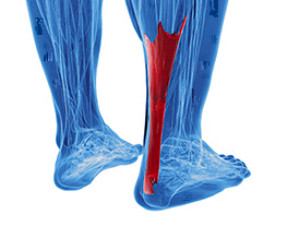 It is extremely important to protect the Achilles tendon. It is located in the back of the leg, and connects the calf muscles to the heel bone. It is the thickest tendon in the body, and can easily tear if it becomes injured. This can happen from frequently participating in running and jumping activities, or from unexpectedly stepping off of a curb. An Achilles tendon injury can cause severe pain and discomfort, and can take several weeks to fully recover. Common symptoms of this type of injury can include extreme tenderness, swelling, and it can often be difficult to walk on. As the healing process occurs, it is beneficial to wear shoes that fit correctly, in addition to performing specific stretches. If you have injured your Achilles tendon, it is strongly suggested that you speak with a podiatrist who can determine what the best treatment options are for you.
It is extremely important to protect the Achilles tendon. It is located in the back of the leg, and connects the calf muscles to the heel bone. It is the thickest tendon in the body, and can easily tear if it becomes injured. This can happen from frequently participating in running and jumping activities, or from unexpectedly stepping off of a curb. An Achilles tendon injury can cause severe pain and discomfort, and can take several weeks to fully recover. Common symptoms of this type of injury can include extreme tenderness, swelling, and it can often be difficult to walk on. As the healing process occurs, it is beneficial to wear shoes that fit correctly, in addition to performing specific stretches. If you have injured your Achilles tendon, it is strongly suggested that you speak with a podiatrist who can determine what the best treatment options are for you.
Achilles tendon injuries need immediate attention to avoid future complications. If you have any concerns, contact Dr. Ronald Sheppard of Warren-Watchung Podiatry Center. Our doctor can provide the care you need to keep you pain-free and on your feet.
What Is the Achilles Tendon?
The Achilles tendon is a tendon that connects the lower leg muscles and calf to the heel of the foot. It is the strongest tendon in the human body and is essential for making movement possible. Because this tendon is such an integral part of the body, any injuries to it can create immense difficulties and should immediately be presented to a doctor.
What Are the Symptoms of an Achilles Tendon Injury?
There are various types of injuries that can affect the Achilles tendon. The two most common injuries are Achilles tendinitis and ruptures of the tendon.
Achilles Tendinitis Symptoms
- Inflammation
- Dull to severe pain
- Increased blood flow to the tendon
- Thickening of the tendon
Rupture Symptoms
- Extreme pain and swelling in the foot
- Total immobility
Treatment and Prevention
Achilles tendon injuries are diagnosed by a thorough physical evaluation, which can include an MRI. Treatment involves rest, physical therapy, and in some cases, surgery. However, various preventative measures can be taken to avoid these injuries, such as:
- Thorough stretching of the tendon before and after exercise
- Strengthening exercises like calf raises, squats, leg curls, leg extensions, leg raises, lunges, and leg presses
If you have any questions please feel free to contact one of our offices located in Marlboro and Watchung, NJ . We offer the newest diagnostic tools and technology to treat your foot and ankle needs.
